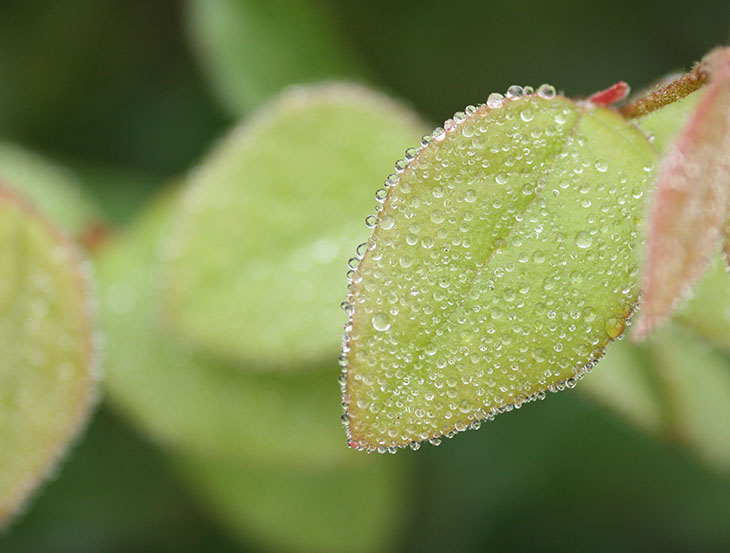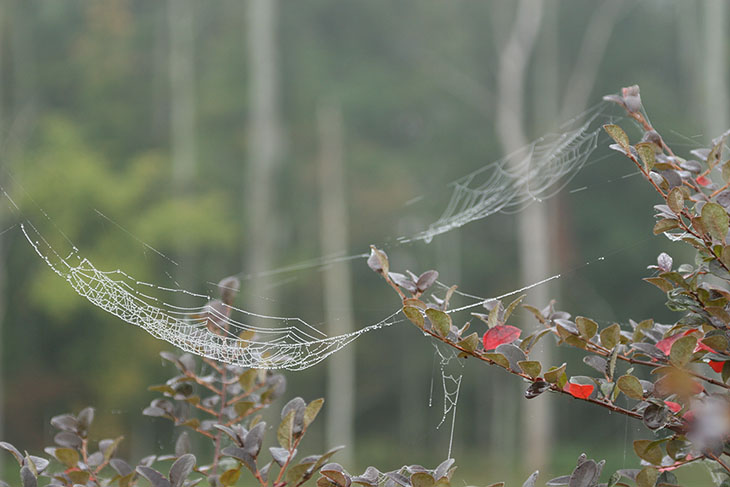
I realized, as I looked outside later in the morning than I should’ve, that we’d had an overnight fog and it still hadn’t cleared completely, so I trotted down to the pond to see if anything interesting could be done with it.
 The last time had been the busy season for the green treefrogs (Hyla cinerea) but they were considerably less abundant this time around; I think it’s late in the season for them, sometimes getting pretty chilly overnight and well past breeding time, so there’s less reason for them to be out. Also, I’ve seen a green heron (Butorides virescens) hanging out around the pond a few times, and they can be hell on the frogs, so that might have had something to do with it. Nevertheless, I found a few to work with, as well as some other items of photographic interest.
The last time had been the busy season for the green treefrogs (Hyla cinerea) but they were considerably less abundant this time around; I think it’s late in the season for them, sometimes getting pretty chilly overnight and well past breeding time, so there’s less reason for them to be out. Also, I’ve seen a green heron (Butorides virescens) hanging out around the pond a few times, and they can be hell on the frogs, so that might have had something to do with it. Nevertheless, I found a few to work with, as well as some other items of photographic interest.
As seen at top, conditions like this are marvelous for revealing just how many spiderwebs exist in any optimal area, and with a dark background, they can stand out quite well in images without the need for bright light. Consider, just for a moment, that the addition of the dew increases their weight by at least tenfold, likely far more – don’t look at me to produce any kind of serious numbers here, since I have no scale for smaller weights to speak of, much less one that could handle the micrograms that even a big web would weigh. If the spiders hang around, they’ll often get just as dew-covered, but this happens rarely; many species will abandon the web and crouch in their safe spot, usually off one upper corner of the web’s main support strands, when the dewpoint hits this strongly. The treefrogs, however, usually like this kind of weather, and if you want to see them during daylight hours, these are the days you aim for. This one posed on the leaf in a way sure to draw the most attention to itself, which must indicate that it’s a young adult female, right? Or does that only apply to humans?
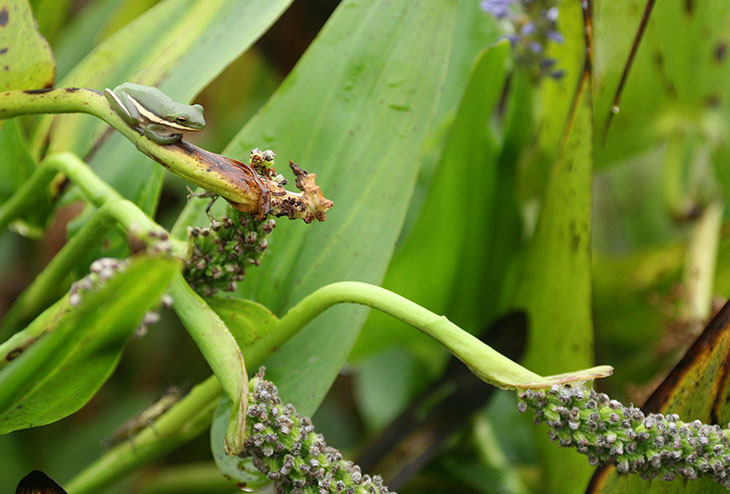
As far as images to provide impressions of the setting go, this one seems to be the most accurate; I like how the frog follows the same lines as the bent stalks (I entirely missed the grasshopper in the background until just now, though.) Yet there are quite a few different approaches that can be taken for subjects like this, and I recommend trying several when given the opportunity.
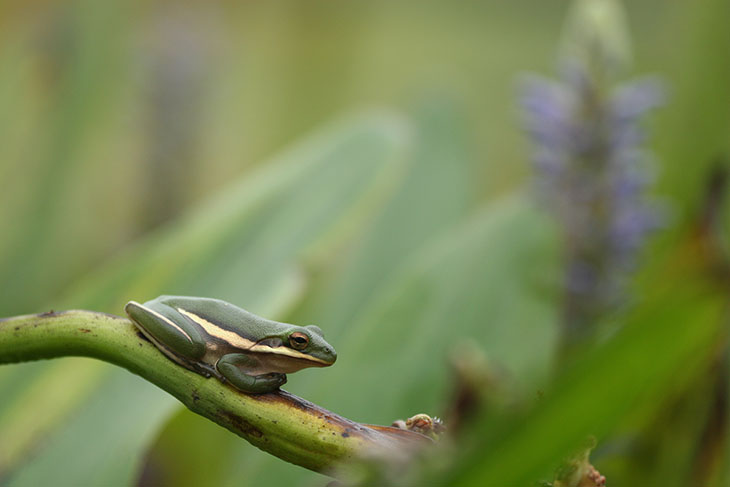
Same frog, different angle and framing – the frogs don’t often perch near the blue flower spikes that pickerelweed produces, so any time I can work an angle that includes them, I’m happy.
This pose is common, reminiscent of how cats often sit, but it likely serves a more useful purpose. Treefrogs rely on the moisture and tactile control of their footpads to cling to vertical and even slick surfaces, so tucking in their legs in this manner helps keep the pads from drying out. It also makes them appear to be a porcelain sculpture – no limbs, just creases. This was shot with an 80mm lens; any closer and I likely would have scared it off.
While wending my way through the pickerelweed growing in the shallows at the edge of the pond, and before that the tall weeds and underbrush bordering the water, I encountered a few more spiders (naturally.) Two massive Argiope aurantias had spun webs across my path at waist height, both of which being discovered when only a half-meter away (they had cleverly positioned their brilliant yellow backs in the opposite direction from my approach,) and one other specimen, a large six-spotted fishing spider (Dolomedes triton,) was found perched on the weeds at the same height.

The dew almost obscured her white abdominal spots (not the ones from the species name, though – those are on the belly instead,) and she remained placidly unconcerned with my close approach, unusually so. I used the blade of my pocketknife to nudge her gently, and she remained in position, idly fending off the nudges with her forelegs before changing position only slightly – very unlike the species. When I switched my own position to provide a better photographing angle, I suddenly realized why she was sticking to her perch so adamantly.
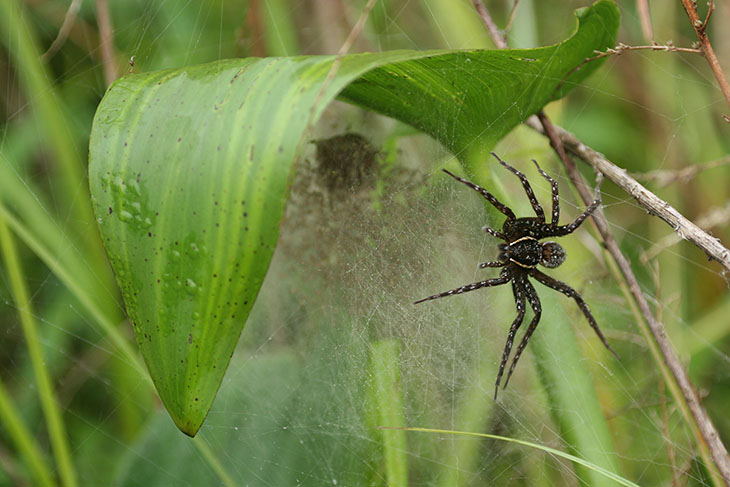
I had approached from the opposite side, and the arched pickerelweed leaf had shielded my view of the cluster web. Fishing spiders don’t really make webs, since they’re free-roaming (and swimming) hunting spiders, but it seems they do when the old biological alarm clock chimes. I was disturbing the proud mother of several hundred little fishers, hatched from the egg sac hidden in the protective webbing, but not yet venturing out on their own – that’s what the out-of-focus haze under the leaf consists of.
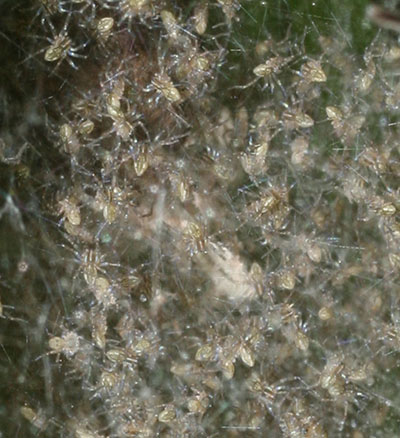 Switching focus to the younguns and using the flash provided a little better view, but not a lot – there were still countless strands of silk in the way to prevent really sharp focus. Still, it’s enough to prove that I wasn’t just seeing chaff or something.
Switching focus to the younguns and using the flash provided a little better view, but not a lot – there were still countless strands of silk in the way to prevent really sharp focus. Still, it’s enough to prove that I wasn’t just seeing chaff or something.
For many spider species, the mother hangs around and runs interference while the newborns spend time in a protected area; to the best of my knowledge, this is all she does, since food sources appropriate for the minuscule babies would be near-impossible for the mother to catch, especially in quantity. A few spider species catch prey that they tear open for the young, while a couple of others actually produce fluid from their mouths that the babies can eat, but I don’t believe either of these traits applies to Dolomedes. This leaves the question of why the young remain in a protective web and under the mother’s watchful eyes for a period of time, and as yet I cannot answer that.
By the way, mama measured roughly 25mm in body length, over 60 counting the leg spread – the babies were 5mm in leg spread at the most. On the previous frog-hunting trip, the fishing spider male that I photographed was in almost the exact same area – it’s possible that I now have images of the entire family. I should go back for closer portraits of the babies and see if there’s any resemblance…
I’ll close with another frame giving an even greater impression of the conditions, new branches on the same species of bush as that supporting the webs in the opening shot. I wish I’d gotten out when the fog was thick, but I still need to pin down a few prime locations that would look the best in such weather. I haven’t found any decrepit abandoned houses nearby yet…
